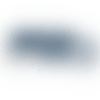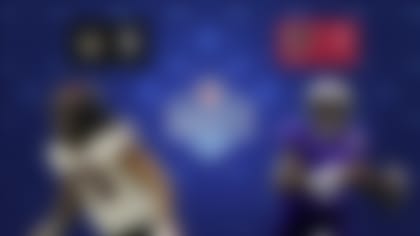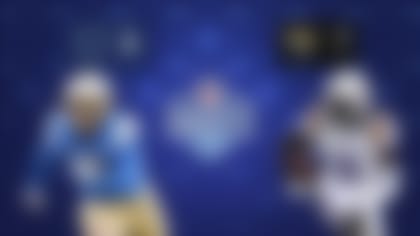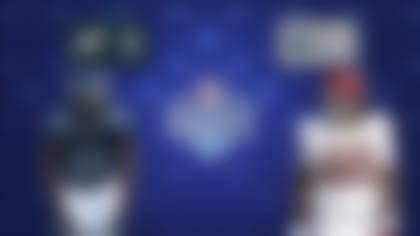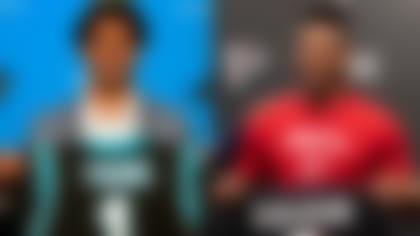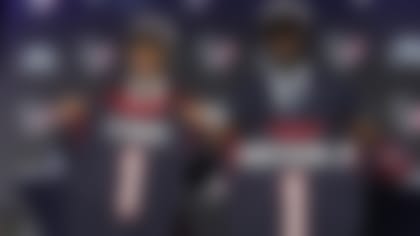Why provide instant grades on the selections of prospects who have yet to take an NFL snap? Well, you're reading this, aren't you? Considering the makeup of every roster and the factors surrounding each pick, Eric Edholm ranks the 2023 draft classes, 1-32. Keep in mind that these grades are based on draft hauls alone -- picks traded for veteran players were not taken into account.
Round 1
- Georgia DT Jalen Carter (No. 9 overall)
- Georgia edge Nolan Smith (No. 30)
Round 3
- Alabama OG Tyler Steen (No. 65)
- Illinois S Sydney Brown (No. 66)
Round 4
- Georgia CB Kelee Ringo (No. 105)
Round 6
- Stanford QB Tanner McKee (No. 188)
Round 7
- Texas DT Moro Ojomo (No. 249)
The rich got richer, for sure. But the thing with the Jalen Carter pick -- the centerpiece of a strong draft class, but a prospect with well-documented character concerns -- is that the Eagles built the perfect environment in which he can thrive. They assembled a veteran-laden D-line over time, already arguably the best in the NFL, and have a bevy of Carter's college teammates on the roster (including two added during this year's draft). They also have no shot to land Carter if GM Howie Roseman didn't make a savvy pre-draft trade a year earlier. Carter might be the best player in this draft; Philadelphia got him with the ninth pick (after a trade up from No. 10) and is a successful enough franchise to be able to survive Carter busting for non-football reasons. One of those other Bulldogs the Eagles nabbed: Nolan Smith. Had he gone to another team in the top 15 or 20 picks, I wouldn't have liked it nearly as much. But scooping him up at the bottom of Round 1 and knowing he doesn't have to be a 50-snaps-per-game player immediately ups the appeal a notch or two. Even if his smaller size poses some issues, the explosive Smith has time to grow into a starting role. Tyler Steen actually has a chance to start in Year 1 if he can make the transition to guard and beat out Cam Jurgens. If not, Steen has extensive OT experience and could make for a quality four-position reserve. Sydney Brown, snatched up one pick after Steen, might be in a similar spot at safety. He has Reed Blankenship and Terrell Edmunds ahead of him on the depth chart. At the very least, the rookie figures to man the third safety role and play special teams. Was Kelee Ringo worth trading a 2024 third-rounder to land? Time will tell, but like with Carter, Philly's roster strength and quality asset management allow this franchise to take smart, calculated gambles on prospects with elite physical traits. Style-wise, Tanner McKee feels like a strange fit, given the quarterbacks the Eagles already have, but who are we to doubt this team's approach when it's clearly firing on all cylinders? I thought Moro Ojomo would have gone 80-to-100 picks earlier. He's now a cheap insurance policy for Carter, which makes it all the better. Sending a fourth-rounder two years from now to the Lions for RB D'Andre Swift was the cherry on top of a stellar draft haul.
Round 1
- Ohio State QB C.J. Stroud (No. 2 overall)
- Alabama edge Will Anderson Jr. (No. 3)
Round 2
- Penn State C Juice Scruggs (No. 62)
Round 3
- Houston WR Tank Dell (No. 69)
Round 4
- TCU edge Dylan Horton (No. 109)
Round 5
- Alabama LB Henry To'oTo'o (No. 167)
Round 6
- Notre Dame C Jarrett Patterson (No. 201)
- Iowa State WR Xavier Hutchinson (No. 205)
Round 7
- Pittsburgh S Brandon Hill (No. 248)
Although it cost them a pretty penny to do so, the Texans landed two of my top three players in the 2023 NFL Draft. I had C.J. Stroud ever so slightly ranked ahead of Bryce Young as the QB1. While part of that is because of Young's tiny build, I also believe Stroud can eventually be a top-12 quarterback in the league with his smart, savvy approach. He could be a strong fit in the Shanahan-influenced offense brought in by new Texans OC Bobby Slowik, and there might be room for Stroud to expand his game with moving pockets and a handful of running opportunities per game. On a team without a ton of elite separators, Stroud's touch and placement will be crucial. Will Anderson Jr. was dinged a bit for his lack of elite size and occasional penchant for sloppiness (penalties and missed tackles), but at his best, he's a Khalil Mack-style game-influencer. Anderson can scream off the edge thanks to elite get-off and close fast with a great internal GPS system. He can be a star in the hands of DeMeco Ryans and Matt Burke, able to rush inside and out, drop in coverage and defend the run. Houston doubled up at center with Juice Scruggs (Round 2) and Jarrett Patterson (Round 6), and based on where they got them, I see Patterson as the better value. Both have good football IQ and versatility to play guard, so there was sense behind the picks, as the O-line still needed padding. Stroud apparently told the Texans he wanted Tank Dell, and I can't wait to see how the diminutive demon is unleashed. He was a wicked cover in college with his stop-start agility and low center of gravity, working mostly out of the slot. The final offensive pick, Xavier Hutchinson, profiles similarly to Jakobi Meyers and could be a security blanket for Stroud. The Texans had three Day 3 selections on the defensive side, one at each level. Dylan Horton adds youth to an experienced defensive line, as well as the ability to rush the passer from multiple techniques. The undersized Henry To'oTo'o continued the run on Alabama players to Houston, bringing green-dot-caliber instincts and smarts to the LB crew -- and also special teams, for that matter. Seventh-rounder Brandon Hill is on the small side, but he plays fast.
Round 1
- Florida QB Anthony Richardson (No. 4 overall)
Round 2
- Kansas State CB Julius Brents (No. 44)
Round 3
- North Carolina WR Josh Downs (No. 79)
Round 4
- BYU OT Blake Freeland (No. 106)
- Northwestern DT Adetomiwa Adebawore (No. 110)
Round 5
- South Carolina CB Darius Rush (No. 138)
- Cal S Daniel Scott (No. 158)
- Miami TE Will Mallory (No. 162)
- Northwestern RB Evan Hull (No. 176)
Round 6
- Wagner edge Titus Leo (No. 211)
Round 7
- Texas A&M CB Jaylon Jones (No. 221)
- Northern Michigan OT Jake Witt (No. 236)
This might be my favorite haul of the Chris Ballard era. The Colts made 12 picks, and I can't really gripe much about any of them, even if I thought the interior offensive line could have used reinforcements. It's clear there was a focus on foraging elite athletic traits, starting with the most important pick of the lot. Anthony Richardson is a complex evaluation, given his small sample size and inconsistent execution, but he's also a truly rare specimen with the arm talent, athletic traits and humble demeanor to be a star in the hands of Shane Steichen. Indianapolis could take its time before inserting Richardson, who turns 21 in late May, into the starting lineup. That said, my gut feeling is that the Colts ride with Richardson in Week 1 and let him work through his mistakes. A lot of the Colts' resources were spent on defense, but Richardson did receive rookie running mates at wideout (Josh Downs), tight end (Will Mallory) and running back (Evan Hull). Downs could be this generation's T.Y. Hilton, a receiver who can take the top off the defense and also uncover in tight spaces, likely from the slot. Mallory never put it all together in college, but he's a plus athlete for the position and has NFL coaching in his bloodlines. Hull could end up being a very capable receiving back and changeup runner, although I'd like to see him clean up his pass pro a bit. Indy also took two long, light-footed OT prospects on Day 3 in Blake Freeland and Jake Witt. Both might be semi-projects, although Freeland at least has big-game experience and 41 college starts at left and right tackle. The secondary saw the most additions, with an obvious need at corner. Julius Brents and Darius Rush will both have opportunities to start. Brents offers elite length (6-foot-3 with 34-inch arms) and shocking quickness (6.63-second three-cone drill), even if he's not overly physical. Rush is almost as long and nearly as athletic, but like Brents, he can play with more force. Jaylon Jones completes the big-CB trio, although he's not as athletically gifted as the other two and might be a year away from potentially contributing. Daniel Scott at least figures to be a special teams standout, but he also has the range and size to be a solid reserve safety. The Colts plan to unleash the athletically freaky Adetomiwa Adebawore as a 3-technique, and his surprising length (nearly 34-inch arms at just 6-2), strength and burst could stress lumbering guards on passing downs. Titus Leo is another long athlete worth developing, although his game remains unrefined.
Round 1
- Illinois CB Devon Witherspoon (No. 5 overall)
- Ohio State WR Jaxon Smith-Njigba (No. 20)
Round 2
- Auburn edge Derick Hall (No. 37)
- UCLA RB Zach Charbonnet (No. 52)
Round 4
- LSU OG Anthony Bradford (No. 108)
- Mississippi State DT Cameron Young (No. 123)
Round 5
- Michigan DL Mike Morris (No. 151)
- Michigan C Olu Oluwatimi (No. 154)
Round 6
- New Mexico S Jerrick Reed II (No. 198)
Round 7
- Georgia RB Kenny McIntosh (No. 237)
The Russell Wilson trade continues to pay dividends, as the Seahawks came into the draft loaded with picks, and they appeared to use them quite well. There are always interesting debates involving Seattle's draft approach, and this year was no different. But the roster appears to be even better on paper now than it was last season, when the team was a surprise playoff entrant. Devon Witherspoon gives the Seahawks the potential for a new version of the Legion of Boom, bolstering the fine secondary picks made last season. The Illinois product's aggressive, assertive style is a great fit, even if matching elite WR speed and strength will be a test for him early. Jaxon Smith-Njigba figures to be a big upgrade over last year's WR3, Marquise Goodwin, and looks like a perfect fit inside, lining up between DK Metcalf and Tyler Lockett. JSN was my WR1 in this class, and here he provides Geno Smith the middle-field target he lacked last season. Derick Hall is another Seattle-style pass rusher to add to the till, along with fifth-rounder Mike Morris. I think Hall could eventually start opposite Uchenna Nwosu, perhaps even immediately. On the surface, the Zach Charbonnet pick feels like the latest chapter in Seattle's annual RB overkill. But dig deeper, and you'll realize that beyond Kenneth Walker III and DeeJay Dallas, the cupboard is pretty bare. Arguably the third-best back in the class, Charbonnet has a great chance to earn the third-down role and spell Walker when needed, although seventh-rounder Kenny McIntosh is a better player than athletic tester and catches the ball well, too. The one frustrating element of this group is that Seattle couldn't address the interior D-line depth earlier, but Cameron Young is a decent run-stopper who can help that need. Anthony Bradford and Olu Oluwatimi were smart Day 3 additions who can provide interior depth on the offensive front. Outside of a few minor quibbles, the Seahawks appear to have significantly upgraded the talent level for a second draft in a row.
Round 1
- Ohio State OT Paris Johnson Jr. (No. 6 overall)
Round 2
- LSU edge BJ Ojulari (No. 41)
Round 3
- Syracuse CB Garrett Williams (No. 72)
- Stanford WR Michael Wilson (No. 94)
Round 4
- UCLA OG Jon Gaines II (No. 122)
Round 5
- Houston QB Clayton Tune (No. 139)
- Auburn LB Owen Pappoe (No. 168)
Round 6
- Louisville CB Kei'Trel Clark (No. 180)
- West Virginia DT Dante Stills (No. 213)
The prevailing theme of the Cardinals' 2023 draft was accumulating assets for the future, both in terms of picks this year and a slew of trades that netted them some exciting 2024 ammunition. They now boast excess draft currency at various stages of next year's draft, with two first-rounders (including Houston's pick), three third-rounders and two fifths. Not moving DeAndre Hopkins was a mild surprise, but that could always change. Paris Johnson Jr. was drafted by the same franchise as his father, and he figures to start Day 1 -- but likely not at left tackle, where D.J. Humphries is under contract for three more years. BJ Ojulari was a good value early in Round 2 and will play a lot early for a team that lacks pass-rush juice. His edge-bending ability ranked at or near the top of this year's entire draft class. Garrett Williams, however, is still rehabbing a torn ACL, but there's optimism he could be back by training camp. When healthy, he's a confident man corner who lacks size but has excellent feel for the position. Michael Wilson stood out at the Reese's Senior Bowl, but can he stay healthy? Injuries ravaged his final three college seasons, so there's risk, yet Wilson could help replace Hopkins one day with his smart approach and sneaky quickness for a thick build. The highly intelligent Jon Gaines II grew on scouts over time, offering three-position versatility at guard and center. Under center, Arizona now has five QBs on the roster, making Clayton Tune's chances of earning a spot on the final 53 tougher, but he has solid feel for the pass game and is a decent athlete with a thickly built frame. Lastly, the Cards' three defensive picks to round out the draft were also good values, all offering plus athleticism for their respective positions. Owen Pappoe and Dante Stills, in particular, graded out as worthy picks that late. The Cardinals haven't had much to cheer about lately, but if GM Monti Ossenfort's navigation of his maiden draft is any indication, the franchise is in good hands.
Round 1
- Utah TE Dalton Kincaid (No. 25 overall)
Round 2
- Florida OG O'Cyrus Torrence (No. 59)
Round 3
- Tulane LB Dorian Williams (No. 91)
Round 5
- Florida WR Justin Shorter (No. 150)
Round 7
- Mississippi OG Nick Broeker (No. 230)
- Oregon State CB Alex Austin (No. 252)
All offseason, I campaigned for the Bills to add a starter-quality slot receiver, and that's what they did in Round 1 -- just not the way I imagined. It was a creative pivot (if that's even the word) to target Dalton Kincaid, leapfrogging the Cowboys via trade to do so at No. 25, right after a four-player run on wide receivers (picks No. 20-23). If Kincaid is healthy, he's an immediate target for Josh Allen, and the Bills can change their stripes and become more of a 12-personnel team, having Kincaid and Dawson Knox out there together and really putting defenses in a bind. If Kincaid and Knox are joined on the field by Stefon Diggs, Gabe Davis and James Cook, opponents will be asked to stop five able, diverse pass catchers at once -- pretty tough. After acquiring Kincaid, the Bills grabbed two prospects well-liked by other teams' scouts: O'Cyrus Torrence and Dorian Williams, both of whom have starting potential at thinner positions. Justin Shorter underachieved at Penn State and always left you wanting a bit more at Florida, but if he's viewed as a low-usage/high-yield WR4, the pick is a decent investment. Nick Broeker adds to the interior OL depth and can also pinch-hit at tackle, so there's a path for him to make the roster. Alex Austin's length and knack for playmaking might make him a decent late steal, if he can contribute on special teams, too. I thought Buffalo maybe would draft a defensive tackle (or two), given that almost every DT on the roster will be up for free agency next offseason, but on the whole, this is a good class from a contender picking at the back ends of most rounds.
Round 1
- Georgia OT Broderick Jones (No. 14 overall)
Round 2
- Penn State CB Joey Porter Jr. (No. 32)
- Wisconsin DT Keeanu Benton (No. 49)
Round 3
- Georgia TE Darnell Washington (No. 93)
Round 4
- Wisconsin edge Nick Herbig (No. 132)
Round 7
- Purdue CB Cory Trice Jr. (No. 241)
- Maryland OL Spencer Anderson (No. 251)
I had listed offensive line, cornerback and defensive line -- in that order -- as the Steelers' biggest needs coming into the draft. Perhaps that's just how the board ultimately lined up, but it's also exactly the way Pittsburgh spent its first three picks. Moving up three spots to draft Broderick Jones not only appeared to snipe him from the Jets but also gave the Steelers a young, ascending talent with plus athleticism to groom as the left tackle of the future -- perhaps as soon as Week 1. Jones offers an enticing combination of length, athleticism and natural power. If he plays with a bit more control, he can be a Pro Bowl player. Joey Porter Jr. certainly made sense from a feel-good perspective, but this wasn't just a nostalgic legacy pick. The younger Porter is a long, lean and highly athletic press corner who cleaned up his tackling and made more plays on the ball last season. His technique could still use a quality car wash, but this was the type of talent Pittsburgh needed at a short-handed position. Keeanu Benton likely made a live pre-draft impression on Mike Tomlin, who was an up-close viewer of Senior Bowl one-on-ones -- drills that made Benton money. He's a thickly built, tenacious rusher with surprising flexibility and length who should contend for steady rookie snaps. Darnell Washington reportedly fell because of some injury concerns, but the massive Georgia product could be a nice fit in Pittsburgh, which can operate in more two-TE sets once this third-round pick is acclimated. His length and athleticism can add another dimension to the offense. The Steelers love their family connections, which didn't end with Porter. Nick Herbig joins big brother Nate and could carve out a role as a pass-rush specialist and special teamer with his relentless style. Cory Trice Jr. adds even more length and athleticism to the secondary, and he easily could have gone 100 picks earlier, so there's a path to making the initial 53-man roster. Spencer Anderson has guard and tackle experience, but might face longer odds to make the team at first.
Round 1
- Tennessee OT Darnell Wright (No. 10 overall)
Round 2
- Florida DT Gervon Dexter Sr. (No. 53)
- Miami CB Tyrique Stevenson (No. 56)
Round 3
- South Carolina DT Zacch Pickens (No. 64)
Round 4
- Texas RB Roschon Johnson (No. 115)
- Cincinnati WR Tyler Scott (No. 133)
Round 5
- Oregon LB Noah Sewell (No. 148)
- Minnesota CB Terell Smith (No. 165)
Round 7
- Kennesaw State DT Travis Bell (No. 218)
- Stanford S Kendall Williamson (No. 258)
After trading down from No. 1 to No. 9, the Bears narrowed their focus to a handful of top prospects. In the end, they felt better about sliding back one more spot and inherently choosing Darnell Wright over Georgia DT Jalen Carter, a move that will be closely analyzed in the coming years. Wright wasn't universally beloved by scouts, but some felt he could be the best tackle in this class if he improves his technique and consistently plays up to his ability. He should start immediately at right tackle. Chicago's biggest need was arguably defensive line, and the team doubled up on Day 2 with Gervon Dexter Sr. and Zacch Pickens. Wisconsin's Keeanu Benton, who went four picks before Dexter, was a better option, but there's promise in this duo -- or trio, if you believe in seventh-rounder Travis Bell. Dexter hasn't put it all together, but his rare length and surprising burst give him a chance. Pickens likewise hasn't produced at an elite rate but possesses some untapped upside and should be a decent gap shooter. Tyrique Stevenson was a personal favorite, even in a loaded CB class, and looks like a strong fit in Matt Eberflus' zone-heavy scheme, bringing feistiness and toughness. Stevenson could start as a rookie opposite Jaylon Johnson. Fourth-rounders Tyler Scott and Roschon Johnson are two other personal favorites. The Bears wanted another home-run threat, and Scott provides that with plus speed, having averaged nearly 45 yards per college TD reception. Johnson has four-down ability -- he's an excellent special-teamer -- and might actually be a better fit for a gap-run scheme than Khalil Herbert. The final four selections came on defense, adding depth to a unit that ranked dead last in points allowed. Of those, Noah Sewell and Terell Smith intrigue me most. Sewell might be a first- and second-down defender only, but he offers good stopping power vs. the run. Smith has the traits to make it here, but he must be more consistent overall.
Round 1
- Alabama RB Jahmyr Gibbs (No. 12 overall)
- Iowa LB Jack Campbell (No. 18)
Round 2
- Iowa TE Sam LaPorta (No. 34)
- Alabama DB Brian Branch (No. 45)
Round 3
- Tennessee QB Hendon Hooker (No. 68)
- Western Kentucky DT Brodric Martin (No. 96)
Round 5
- William & Mary OG Colby Sorsdal (No. 152)
Round 7
- North Carolina WR Antoine Green (No. 219)
There is a fair and reasonable argument to be had about positional value in the draft. Detroit's approach appeared to fly in the face of modern convention, with the Lions taking a 199-pound running back (Jahmyr Gibbs) and an off-ball linebacker who I thought would be a mid second-rounder (Jack Campbell) in the draft's first 18 selections. They sought out players who fit them as opposed to being beholden to a league-value board. Whatever your philosophy is on this, it's hard to argue Detroit wasn't better by the end of Round 1. Gibbs could be a superior playmaker to D'Andre Swift (who was traded to Philadelphia on Day 3 of the draft), impacting the game as a runner, receiver and returner. The Lions know they'll need his juice with Jameson Williams suspended for the first six games of next season. Campbell figures to start alongside Alex Anzalone, despite Malcolm Rodriguez showing promise as a rookie. The 6-foot-5, 249-pound 'backer tested quite well at the NFL Scouting Combine and has the ability to defend the run and pass (particularly as a zone dropper). The next two picks, Sam LaPorta and Brian Branch, could also start or contribute heavily in Year 1. LaPorta, who has a spirited play style, gives the Lions the quality receiving option at tight end they've lacked since trading T.J. Hockenson to Minnesota. The smart, versatile Branch could wear a lot of hats in the secondary, freeing up Detroit to move C.J. Gardner-Johnson all over the field. The Lions were always a team Hendon Hooker made sense for, and Round 2 would have been a reasonable time to pull the trigger, so getting him a round later to groom behind Jared Goff was a smart play. Hooker has some challenges to overcome to become a starter, but the tools are all there. The Lions' final three picks felt like traits-based reaches at need positions. Brodric Martin wasn't my favorite defensive tackle, but he moves pretty well for his mass and can stop the run. Colby Sorsdal might just have the length to be groomed as a swing tackle. Despite being a 46-game starter at William & Mary, though, he has only played the right side. Antoine Green has decent length and vertical speed, but looks more like a practice-squad candidate to start.
Round 1
- Iowa edge Lukas Van Ness (No. 13 overall)
Round 2
- Oregon State TE Luke Musgrave (No. 42)
- Michigan State WR Jayden Reed (No. 50)
Round 3
- South Dakota State TE Tucker Kraft (No. 78)
Round 4
- Auburn DT Colby Wooden (No. 116)
Round 5
- Penn State QB Sean Clifford (No. 149)
- Virginia WR Dontayvion Wicks (No. 159)
Round 6
- Bowling Green DT Karl Brooks (No. 179)
- Auburn K Anders Carlson (No. 207)
Round 7
- Kentucky CB Carrington Valentine (No. 232)
- Central Michigan RB Lew Nichols III (No. 235)
- Iowa State S Anthony Johnson Jr. (No. 242)
- Charlotte WR Grant DuBose (No. 256)
The Packers made 13 selections, and clearly not all of them will make the opening 53-man roster. But the team's overall approach appeared solid, thoughtful and mostly smart, even if Green Bay is always good for a head-scratcher or two every year. Lukas Van Ness could follow the Rashan Gary development plan and be more of an impact defender in future years than as a rookie in 2023. But with Gary currently rehabbing a torn ACL, LVN's inside-outside versatility and grown-man power should give him a real chance to crack the lineup early. I'm not sure he's a star in the making, but he absolutely can become a Preston Smith-caliber contributor in time. Doubling up at tight end, with Luke Musgrave in Round 2 and Tucker Kraft in Round 3, was a fascinating approach and could open up far more 12 personnel possibilities than the Packers have had in a few years. It's a tad surprising they took two similarly built tight ends with overlapping skill sets, but the duo could allow Green Bay to tinker with alignments and put opposing defenses in a bind with their own personnel decisions. The Jayden Reed pick in Round 2 also took me by surprise, given that he doesn't meet typical Green Bay WR benchmarks. Still, he can be a quality return man and slot who gives you excellent YAC. Colby Wooden and Karl Brooks look like 5-technique candidates. You'd like to see Wooden add a little bulk; Brooks' biggest question at that spot is with his lack of length. Following the Reed outlier, the Packers took two more typecast receivers in Dontayvion Wicks and Grant DuBose, who have the length and enough vertical ability to provide depth outside. Round 7 was a pretty fruitful haul, with Green Bay landing Carrington Valentine, Lew Nichols III, Anthony Johnson Jr. and DuBose. Keep an eye on Johnson, who has CB experience and could make the roster if the Packers aren't shopping for a veteran safety. The two most interesting Day 3 picks were Sean Clifford and Anders Carlson. Clifford never looked like an NFL quarterback to me, but he did beat out Will Levis at Penn State and has the intangibles sought in a QB3. Carlson's arrival doesn't necessarily spell the end of Mason Crosby's run, but that's looking like a real possibility now.
Round 1
- Texas RB Bijan Robinson (No. 8 overall)
Round 2
- Syracuse OG Matthew Bergeron (No. 38)
Round 3
- Ohio State DE Zach Harrison (No. 75)
Round 4
- Utah CB Clark Phillips III (No. 113)
Round 7
- Alabama S DeMarcco Hellams (No. 224)
- South Carolina C Jovaughn Gwyn (No. 225)
With the selection of Bijan Robinson, the Falcons now have top-10 picks at receiver (Drake London), tight end (Kyle Pitts) and running back. Robinson is a special talent, so much so that we can't even gripe that the Falcons already had a young 1,000-yard rusher (Tyler Allgeier) on the roster. During his Texas career, Robinson's receiving ability was underutilized, and I think he can do for the Falcons what Marshall Faulk did for the Rams years ago. He's likely to thrive in Arthur Smith's run game, and the Falcons are assembling a good offensive line in front of Robinson. That unit was bolstered by the second-round pick of Matthew Bergeron, one of the best run-blocking O-line prospects in this year's class. He was a college tackle but might project best to guard, where the Falcons have an open starting job on the left side. I expect Bergeron to be the favorite coming into camp. Seventh-rounder Jovaughn Gwyn is a quality run blocker, as well, although he's undersized and likely will need to play center. Zach Harrison was the Falcons' first defensive pick, and it comes at a spot of perennial need. Harrison has never been a big sack producer (13 in four seasons at Ohio State) but he has been disruptive with active hands (five forced fumbles, seven batted passes the past two seasons), good length and nice athletic traits. The Falcons didn't address the secondary until Round 4, but they found two excellent values in Clark Phillips III and DeMarcco Hellams. There are some decent nickel back options on the team, but Phillips has an excellent chance to win that job eventually with great instincts and quickness, and a track record of ball production. Hellams is a solid, fairly versatile safety who lacks great athletic ability (namely speed) but maximizes it with good instincts and a knack for arriving at the ball on time.
Round 1
- Maryland CB Deonte Banks (No. 24 overall)
Round 2
- Minnesota C John Michael Schmitz (No. 57)
Round 3
- Tennessee WR Jalin Hyatt (No. 73)
Round 5
- Oklahoma RB Eric Gray (No. 172)
Round 6
- Old Dominion DB Tre Hawkins III (No. 209)
Round 7
- Oregon DT Jordon Riley (No. 243)
- Houston S Gervarrius Owens (No. 254)
You can't really compare GM Joe Schoen's maiden draft in 2022 to his haul this year, simply because of the lack of high picks this time around. Last year, the Giants made seven of the first 114 selections; this year, they ended up with just three in the first 171. But New York still appeared to do well this year, both in terms of value and fit -- especially with the first four picks. Deonte Banks addressed an immediate need at corner, and to get him as the draft's CB4 (trading up one slot to snag him) was a nice draw. He has a great chance to start immediately opposite Adoree' Jackson and appears to be a fine fit for a Wink Martindale defense. John Michael Schmitz might also be favored to win the starting center job, and Big Blue landed him in a good spot. With the crosstown Jets also drafting a Round 2 center (Joe Tippmann), the rookies' careers are likely to be compared often. I wasn't the biggest Jalin Hyatt fan, but that also came with the idea that some team could spend a top-50 pick on him. At No. 73, that blazing speed -- something the Giants sorely lacked at receiver last year -- was well worth the investment. (Minor quibble: They now have a lot of slot options but are not as deep outside, and I think Hyatt best projects inside.) The intriguing Eric Gray has good vision and some third-down ability, and he provides a layer of insurance with the future of Saquon Barkley still unknown. Tre Hawkins III and Gervarrius Owens provide more secondary depth, and Jordon Riley beefs up the D-line.
Round 1
- Boston College WR Zay Flowers (No. 22 overall)
Round 3
- Clemson LB Trenton Simpson (No. 86)
Round 4
- Mississippi edge Tavius Robinson (No. 124)
Round 5
- Stanford CB Kyu Blu Kelly (No. 157)
Round 6
- Oregon OL Malaesala Aumavae-Laulu (No. 199)
Round 7
- USC OG Andrew Vorhees (No. 229)
With Lamar Jackson agreeing to a five-year extension hours before the draft began, last week was already deemed a success for the Ravens before they'd even made a single pick. That had to streamline the process significantly for GM Eric DeCosta and the rest of the front office to attack the trouble spots on the roster, which once again is that of a contender now that the QB1's officially on board. I thought Baltimore might go with Maryland CB Deonte Banks at No. 22 overall, considering the need, but had no problem whatsoever with the selection of Zay Flowers. In fact, Flowers was my WR2 in this draft class, ranked 18th regardless of position. I love his shifty playmaking skills, which -- dare I say -- remind me somewhat of vintage Antonio Brown. I think the "Ravens can't draft receivers" talk is due to subside once Flowers gets going, likely as a slot weapon. Baltimore always does a nice job of marrying short-term need, long-term vision and draft value, and the Trenton Simpson pick was a reflection of that. The highly athletic linebacker wasn't my favorite player to scout, but he was absolutely worth the No. 86 overall pick and could play a number of roles in time, assuming Simpson can't beat out Patrick Queen at some point this season. Tavius Robinson has taken a fascinating path to where he is now and looks like the kind of long, somewhat-twitchy rush end the Ravens like to target and groom over time. Kyu Blu Kelly has decent length, NFL bloodlines (son of former Bucs DB Brian Kelly) and is mature enough to crack the CB rotation early in his career. The final two picks were long-term investments in the offensive line. Malaesala "Sala" Aumavae-Laulu has plenty to clean up in an unrefined game, but boasts power and length and could be tried as a tackle or guard. Baltimore traded back into the draft to take Andrew Vorhees, who suffered a torn ACL at the NFL Scouting Combine but came back the next day to bang out a class-best 38 reps on the bench press. He's a 2024 player, most likely, but can add experience, versatility, grit, toughness and smarts to the room when healthy.
Round 1
- Clemson edge Myles Murphy (No. 28 overall)
Round 2
- Michigan CB DJ Turner II (No. 60)
Round 3
- Alabama S Jordan Battle (No. 95)
Round 4
- Purdue WR Charlie Jones (No. 131)
Round 5
- Illinois RB Chase Brown (No. 163)
Round 6
- Princeton WR Andrei Iosivas (No. 206)
- Michigan P Brad Robbins (No. 217)
Round 7
- Miami CB D.J. Ivey (No. 246)
The pass rush was an area that needed a little bolstering, so grabbing Myles Murphy near the end of Round 1 felt like a solid play. Murphy can spell Trey Hendrickson and Sam Hubbard and also join them on a third-down package that floods quarterbacks with three or four pass rushers on the field together. Bottom line: No one's expecting Murphy to be a Day 1 starter here, but his length, mass and athleticism will be used right away. There might be somewhat-similar expectations for Cincinnati's next four picks, to varying degrees. DJ Turner II should be expected to contribute right away, but likely won't crack the top three CB spots. Turner's speed (combine-best 4.26 40-yard dash) and short-area quickness make him a natural slot option, perhaps as Mike Hilton's eventual replacement. The Jordan Battle pick was a bit of a surprise, given Cincy's depth at safety, but I'm not betting against him pushing Nick Scott for a job eventually. Charlie Jones might be the team's starting punt and kick returner, could beat out Trenton Irwin for WR4 duties and might eventually replace Tyler Boyd, who is in the final year of his deal. As of now, Joe Mixon is on the roster and the presumed starter -- until he isn't. But Chase Brown absolutely cannot be counted out of this year's RB rotation, not with Samaje Perine gone and Mixon's status unclear amid his off-field legal issues. Brown was a workhorse for the Illini, but in the NFL, he might be best in a change-of-pace or third-down role. Andrei Iosivas has more deep speed than Jones but is less polished all around and might need a redshirt year. A sixth-round pick at punter, Brad Robbins figures to have a better chance to win the job than incumbent Drue Chrisman because of his hangtime, bad-weather experience and FG-holding ability. Seventh-rounder D.J. Ivey was a height-weight gamble late who finally developed in his last year at Miami.
Round 1
- Oregon CB Christian Gonzalez (No. 17 overall)
Round 2
- Georgia Tech DE Keion White (No. 46)
Round 3
- Sacramento State LB Marte Mapu (No. 76)
Round 4
- Troy C Jake Andrews (No. 107)
- Maryland K Chad Ryland (No. 112)
- Eastern Michigan OG Sidy Sow (No. 117)
Round 5
- UCLA OG Atonio Mafi (No. 144)
Round 6
- LSU WR Kayshon Boutte (No. 187)
- Michigan State P Bryce Baringer (No. 192)
- Liberty WR Demario Douglas (No. 210)
- Michigan State CB Ameer Speed (No. 214)
Round 7
- Jackson State CB Isaiah Bolden (No. 245)
From a league-value standpoint, Christian Gonzalez and Keion White could be considered smart and perhaps safe picks by New England to kick things off. Corner was a need, and Gonzalez's length and athleticism give the Patriots -- who landed him after trading down from No. 14 to No. 17 -- even more flexibility, coverage-wise. They'll ask him to be a more physical tackler and maximize his traits further, but this could be a big hit in a year or two. White was a bit of a late bloomer in college and could have limited upside, but he's a multi-position performer with elite athletic traits. It's clear with Matt Groh overseeing the past two drafts that the Patriots have put more emphasis on upgrading the athletic quotient. Marte Mapu was a classic Day 2 Patriots pick, matching sort of a Kyle Dugger template with excellent special-teams value. Spending three picks on interior offensive linemen and two on specialists is the Patriots' way of reminding you that they do business a bit differently than other teams, but that approach has paid off for them in the past. Of those picks, Sidy Sow (who has some tackle versatility), Atonio Mafi and Bryce Baringer seem to me to have the best chance to redeem their draft value. There was reason for excitement in Round 6 with the selections of Kayshon Boutte and Demario Douglas. Both could end up making this team in August. Also keep an eye on Isaiah Bolden, who could be a freaky-traits steal. I thought a tight end might be on the menu, and they were reportedly interested in trading back into Round 1 late; might Dalton Kincaid have been their guy?
Round 3
- Tennessee WR Cedric Tillman (No. 74 overall)
- Baylor DT Siaki Ika (No. 98)
Round 4
- Ohio State OT Dawand Jones (No. 111)
- Missouri edge Isaiah McGuire (No. 126)
Round 5
- UCLA QB Dorian Thompson-Robinson (No. 140)
- Northwestern CB Cameron Mitchell (No. 142)
Round 6
- Ohio State C Luke Wypler (No. 190)
The Browns had to sit on their hands for two-plus rounds, but once they got into the draft, they didn't waste time finding talent. Cedric Tillman likely would have gone at least a round higher if injuries hadn't significantly impacted his senior campaign at Tennessee; the 12-touchdown season in 2021 was quite impressive. There is a track toward a starting role in Cleveland if Tillman can add more subtlety to his routes, adjust to this new offense and stay healthy. There's no reason why Siaki Ika can't compete for regular snaps right away. The Browns have been bullied up front by opposing run games for a minute now, and Ika's strength is, well, his strength. The 6-foot-3, 335-pounder can really root down in the trenches. Even as the league has gotten away from this type of nose tackle somewhat, the value of getting him at No. 98 felt very good. The Browns then added more beef in Round 4 with two players who also could have cracked Day 2 in Dawand Jones and Isaiah McGuire. Jones is in good hands with OL coach Bill Callahan. The 6-8, 374-pounder has the mass, strength and length to be a people mover at right tackle or guard. McGuire has the frame to back up Myles Garrett and rotate in up front, especially with 2022 third-rounder Alex Wright still somewhat of an unknown quantity. The Browns have an overloaded QB room with four guys right now, but they could absolutely keep three if Dorian Thompson-Robinson impresses this summer. He's experienced, athletically gifted and showed tangible strides the past few years -- a good match, skill-wise, behind Deshaun Watson and Joshua Dobbs. Fifth-round CB Cameron Mitchell joins former Northwestern teammate (and friend since grade school) Greg Newsome II. Mitchell isn't big, but he has a good feel for coverage and route recognition. That said, he could stand to make plays on the ball more consistently. Luke Wypler might be a center-only prospect, but has the toughness and smarts to be groomed as a rookie before potentially vying for the starting job down the road.
Round 1
- Texas Tech edge Tyree Wilson (No. 7 overall)
Round 2
- Notre Dame TE Michael Mayer (No. 35)
Round 3
- Alabama DT Byron Young (No. 70)
- Cincinnati WR Tre Tucker (No. 100)
Round 4
- Maryland CB Jakorian Bennett (No. 104)
- Purdue QB Aidan O'Connell (No. 135)
Round 5
- Georgia S Christopher Smith II (No. 170)
Round 6
- Florida LB Amari Burney (No. 203)
Round 7
- Arizona State DT Nesta Jade Silvera (No. 231)
Tyree Wilson earned some Chandler Jones comps during the pre-draft run, so it's only fitting that Wilson could emerge as Jones' eventual replacement in Las Vegas. It's possible that Wilson's arrival spurs Jones to a rebound season, but whenever the No. 7 overall pick sees the field, his length and burst will add some real juice to the pass rush opposite Maxx Crosby. Landing Michael Mayer in Round 2 was a really sound addition. Nothing against the tight ends already on the roster, but Mayer is clearly the best all-around option. The Notre Dame product can upgrade Vegas' run blocking and should be a very nice outlet for new QB Jimmy Garoppolo. From that point on, the Raiders' draft was up and down. On the high side, Jakorian Bennett addressed the big need at corner. It was later than I thought the Raiders would take one, but Bennett's speed and playmaking instincts could have him in the starting lineup before long. Christopher Smith II and Amari Burney were two other defensive picks I liked, with Smith's football IQ and Burney's versatility as a box defender likely to add something to that unit. Aidan O'Connell's skill set is a good match for Josh McDaniels, providing insurance behind the injury-prone Garoppolo, even if the upside is limited. I was less enthused with the Tre Tucker pick. With other, more well-rounded receivers on the board, the Raiders opted for a speedy but limited weapon. Byron Young and Nesta Jade Silvera provide DT depth, but only so much promise. The top two picks give the Raiders a chance to make this a very good class, even if a few later picks left me ambivalent.
Round 1
- TCU WR Quentin Johnston (No. 21 overall)
Round 2
- USC edge Tuli Tuipulotu (No. 54)
Round 3
- Washington State LB Daiyan Henley (No. 85)
Round 4
- TCU WR Derius Davis (No. 125)
Round 5
- Clemson OG Jordan McFadden (No. 156)
Round 6
- Boise State DT Scott Matlock (No. 200)
Round 7
- TCU QB Max Duggan (No. 239)
Quentin Johnston made plenty of sense as the Chargers' first-round selection. There are questions about his drop rate and whether he maximizes his physical traits well enough, but Johnston does provide playmaking ability to an offense that felt one playmaker short a year ago. Johnston really does feel like a Mike Williams clone in a lot of ways. In a similar respect, Tuli Tuipulotu provides much-needed insurance for Joey Bosa and Khalil Mack. The pass rush sagged when Bosa missed time, and Mack was asked to play more than 80 percent of the team's defensive snaps last year at age 31. Tuipulotu isn't yet a finished product (and won't turn 21 until September) but has the quickness and aggressive nature to spell those starters while providing juice off the bench. Daiyan Henley should get a chance to replace Kenneth Murray in time, and though they share some traits -- including some occasionally shaky play recognition -- Henley's burst and toughness will improve the LB unit. Johnston's TCU running mate, Derius Davis, might make his biggest immediate contribution as a punt returner (five TDs on 44 college returns). Davis is tiny but also could carve out a specialist role on offense: deep shots, jet sweeps, trick plays, etc. Jordan McFadden was a college tackle who might project inside. Perhaps a guard wasn't the biggest need, but the Bolts' recent success in OL draft picks has earned them credibility. Scott Matlock is a flier who might be able to help a leaky run defense. And just to bring the TCU thing full circle, Los Angeles used its last pick on Max Duggan, who is tough and competitive -- but also an inaccurate passer.
Round 1
- Northwestern OL Peter Skoronski (No. 11 overall)
Round 2
- Kentucky QB Will Levis (No. 33)
Round 3
- Tulane RB Tyjae Spears (No. 81)
Round 5
- Cincinnati TE Josh Whyle (No. 147)
Round 6
- Maryland OT Jaelyn Duncan (No. 186)
Round 7
- Tennessee-Martin WR Colton Dowell (No. 228)
The big story of the Titans' draft was their second-round pick. They traded up eight spots in Round 2 to end the freefall of Will Levis, who was widely projected to be a first-rounder. The Kentucky product's game is flawed, and he took a step backward last season, but Levis' athletic build, big arm and terrific confidence appear to be good fits for a Mike Vrabel-coached team in the play-action offense Tennessee's expected to run. Assuming Ryan Tannehill enters this season as the starter, Levis will have every chance to unseat Malik Willis as QB2 and eventually take over for Tannehill, who's in a contract year. Every pre-draft debate about first-rounder Peter Skoronski focused on his short arm length and whether he'd play tackle or guard in the NFL. The first topic might be passé now, but the latter question still lingers in Tennessee. Skoronski should start right away, either at left tackle or left guard, depending on how free agent Andre Dillard fares on the blind side. Skoronski's technical ability is very strong, along with his physicality in both the run and pass games. He's a ready-made pro who should be very good in the long run. The Titans grabbed more of a pure OT prospect later in Maryland's Jaelyn Duncan, who has the traits to be a starting left tackle but is maddeningly inconsistent and might need hard coaching to max out his natural gifts. Depending on the health of his knee, Tyjae Spears could be a terrific value. He went on an eight-game tear to finish last season and then carried that over into a strong week at the Senior Bowl. There are questions about Spears' long-term durability, but he has electric ability as a third-down back and changeup to the power of Derrick Henry. The remaining Day 3 picks were also on offense, with Josh Whyle and Colton Dowell adding depth to the pass-catching units. Whyle got a bit lost in a loaded TE draft class, but he's a sneaky-good athlete with the height to be a red-zone threat and enough blocking skill to carve out a regular role in time.
Round 1
- Alabama QB Bryce Young (No. 1 overall)
Round 2
- Mississippi WR Jonathan Mingo (No. 39)
Round 3
- Oregon edge DJ Johnson (No. 80)
Round 4
- N.C. State OG Chandler Zavala (No. 114)
Round 5
- Florida State DB Jammie Robinson (No. 145)
There are no guarantees in the NFL, and the Panthers traded four picks along with a quality receiver to spend the first overall pick on a quarterback whose small frame set a historic precedent. But Bryce Young possesses the rare processing ability and field vision to become an excellent player. The durability questions likely won’t go away until he’s proven he can play a few full seasons, but Young’s pocket feel and decent athleticism can help him avoid hits. One of Young's best traits emerged last season, when he covered up for a surprisingly high number of problems on Alabama's offense -- and he likely will be asked to do something similar for Frank Reich as a rookie, given that Young doesn't yet have all the complementary pieces around him in Carolina. Jonathan Mingo will help at receiver, but how soon? His physical gifts are pretty clear, but we thought Mingo was a bit of a reach, even in a weaker WR class. Having worked with a more streamlined route tree at Ole Miss, Mingo might require time to adjust. He's also built similarly to many of the Panthers' other receivers. DJ Johnson went about a round too soon; Carolina might have been able to snag him with the fourth-round pick (No. 132) that was given to Pittsburgh in the trade up to get him in Round 3. Johnson emerged last season after moonlighting at tight end for Oregon but remains something of a project, and he'll turn 25 in October. If he can hone his elite athletic traits, Johnson could develop into a situational rusher this season. We loved the Panthers' final two selections. Fourth-rounder Chandler Zavala has some durability concerns, given his long medical history, but he looked like one of the most capable guards in this draft class. He's a tireless worker and strong finisher in the run game and will provide insurance for Austin Corbett, who is coming off a torn ACL. Jammie Robinson is a versatile DB who potentially fills needs at both safety and the nickel spot. Although his size is underwhelming, Robinson brings a passionate, urgent play style to a secondary that has more flexibility now.
Round 1
- Iowa State edge Will McDonald IV (No. 15 overall)
Round 2
- Wisconsin C Joe Tippmann (No. 43)
Round 4
- Pittsburgh OT Carter Warren (No. 120)
Round 5
- Pittsburgh RB Israel Abanikanda (No. 143)
Round 6
- Western Michigan LB Zaire Barnes (No. 184)
- LSU CB Jarrick Bernard-Converse (No. 204)
Round 7
- Old Dominion TE Zack Kuntz (No. 220)
Considering the major need at offensive tackle, the pick of edge rusher Will McDonald IV was a stunner early on. The Jets had to know that dropping down two slots in Round 1 as part of the trade with Green Bay for Aaron Rodgers could cost them a shot at one of the top blockers in this class. Such was the price of doing business; Broderick Jones was snagged by the Steelers at No. 14, one pick ahead of New York, after Pittsburgh traded with the Patriots to move into that position. We agree that McDonald could be a terror off the edge if he's not asked to rush from a 4i alignment as much as he did for the Cyclones. Was it the biggest need? The best value? Maybe not, but it could be a move that pays off down the road. It feels like the Jets were very fortunate to land Joe Tippmann and Carter Warren where they did. Tippmann received some late Round 1 buzz, and I thought Warren could go late in the third. Both could be in line to start at some point this season, perhaps earlier than some realize. The selection of Israel Abanikanda could end up being a real hit. With Breece Hall coming off an ACL injury and Michael Carter still needing to prove his worth, "Izzy" could earn a role quickly and contribute right away with his vision and burst. I thought the Jets might consider boosting their linebacker and DB depth a tad earlier than they did with the selections of Zaire Barnes and Jarrick Bernard-Converse, but both could crack the roster via special teams. And even with the Jets pretty deep at tight end, it was worth taking a risk in Round 7 on Zack Kuntz, a likely practice-squad developmental player. The Jets certainly brushed off age as a concern, as most of the picks will be between 23 and 24 years old as rookies. On the whole, it looks like a solid draft class.
Round 1
- Clemson DT Bryan Bresee (No. 29 overall)
Round 2
- Notre Dame edge Isaiah Foskey (No. 40)
Round 3
- TCU RB Kendre Miller (No. 71)
Round 4
- Old Dominion OG Nick Saldiveri (No. 103)
- Fresno State QB Jake Haener (No. 127)
Round 5
- Minnesota S Jordan Howden (No. 146)
Round 6
- Wake Forest WR A.T. Perry (No. 195)
The Saints focused on upgrading the front seven with their first two selections, then turned to help the offensive side with most of the remainder. Bryan Bresee was a tricky evaluation in that he possesses all the tools to be an excellent defensive lineman but had spotty production in college and carries a concerning injury history. But Bresee's hot motor and positional versatility, along with the surprising pop and explosion in his play, give him an excellent chance to thrive, with better health. Isaiah Foskey also was tough to scout, but for different reasons. He's an athletic marvel -- nearly the perfect prototype for how you want an athletic edge to be built. But his tape was incomplete, with flashes of brilliance but too many stalled-out rushes. Foskey plays with full intensity, has had good sack production and even has been an adept kick-blocker, but he might need time to add pass-rush tricks to his bag. Finding RB help was important, given Alvin Kamara's off-field issues, and Kendre Miller was an interesting choice. He's a bit upright in his run style but has good thickness and sneaky wiggle and always seems to be falling forward. Miller could be an excellent complement as a first- and second-down back and can carry the load, as he showed in a gutsy effort (29 carries) vs. Kansas State. The Saints already appear to be planning for life after Andrus Peat and Cesar Ruiz, and Nick Saldiveri could help fill one of their roles at guard. He spent the majority of his time at Old Dominion at right tackle but might be more effective inside, where his range and recovery ability might not be as concerning. So, which are we going with: "Fresnola" or "Fresneaux State?" That's the question after the Saints drafted Jake Haener to back up Bulldogs legend Derek Carr. Either way, the QB room is vastly improved, and Haener's smart, focused, detailed approach could make him an excellent No. 2. Jordan Howden has solid backup written all over him on defense but could turn into a quality special-teamer. A.T. Perry was a nice late steal. He's a bit inconsistent catching the ball and doesn't have great play strength, but he does have the ball-tracking ability and red-zone skill to push Tre'Quan Smith for a job.
Round 1
- Michigan DT Mazi Smith (No. 26 overall)
Round 2
- Michigan TE Luke Schoonmaker (No. 58)
Round 3
- Texas LB DeMarvion Overshown (No. 90)
Round 4
- San Jose State edge Viliami Fehoko Jr. (No. 129)
Round 5
- North Carolina OL Asim Richards (No. 169)
Round 6
- Southern Mississippi CB Eric Scott Jr. (No. 178)
- Kansas State RB Deuce Vaughn (No. 212)
Round 7
- South Carolina WR Jalen Brooks (No. 244)
The Cowboys hadn't spent a first-round pick on an interior defensive lineman since Russell Maryland in 1991, and it was fair to wonder -- prior to them taking Mazi Smith -- just how much this staff truly valued nose tackle. It's also fair to wonder if Dalton Kincaid might have been the guy they wanted at No. 26, before Buffalo leapfrogged Dallas to secure the Utah tight end's services. Still, the Cowboys have failed to stop the run in some critical games, and the dancing-bear Smith is expected to help on that front. Luke Schoonmaker might feel like a concession pick at tight end if they had their sights set higher, but he really is a good, functional, all-around player who should round that position group into form. DeMarvion Overshown and Viliami Fehoko Jr. were smart pieces to add to a defense that needed another layer of depth, and I can envision Overshown being a nice special teams player. That said, Overshown and Fehoko's immediate contributions might not be that significant, which also could be the case with Asim Richards. If he can make the switch to guard, perhaps he can vie for a starting role as a rookie; otherwise, he rates as a versatile reserve. Eric Scott Jr. and Jalen Brooks were also late-round fliers at positions that needed fresh bodies; the Cowboys were shorthanded at corner and receiver late last year. I'm probably not alone in being hyped about the Deuce Vaughn pick, and not just because it gave us one of the great tearjerker moments of the 2023 NFL Draft. The 5-foot-5, 179-pounder legitimately could and should crack that RB depth chart, add some real juice to the offense and be a fan favorite by halftime of the preseason opener. It's a mostly unsexy crop, but a fairly respectable one.
Round 1
- Kansas State edge Felix Anudike-Uzomah (No. 31 overall)
Round 2
- SMU WR Rashee Rice (No. 55)
Round 3
- Oklahoma OT Wanya Morris (No. 92)
Round 4
- Virginia Tech DB Chamarri Conner (No. 119)
Round 5
- Stephen F. Austin State edge BJ Thompson (No. 166)
Round 6
- Texas DT Keondre Coburn (No. 194)
Round 7
- Ball State CB Nic Jones (No. 250)
Felix Anudike-Uzomah had the look of a Chiefs-y prospect, so it was no shock they took the K-State product where they did; he'd have been gone a handful of picks into Round 2 had they not. He'll spell the edges and work inside, too, allowing Steve Spagnuolo to roll out more pass-rush packages. Kansas City needs to replace more than 100 catches and 1,200 yards from last season with the departures of JuJu Smith-Schuster and Mecole Hardman, so using a higher pick on a receiver made sense. Whether Rashee Rice was the right addition for this offense is going to be an interesting subplot to track. On the one hand, his subtle gear changes and body control are excellent, and he was quite productive at SMU. But Rice also doesn't play strong and is guilty of concentration drops. He figures to play early on, but could have a limited role if Kadarius Toney and Skyy Moore prove more reliable. The Wanya Morris pick was interesting. He figures to open as the swing tackle but could end up starting on the right side if Lucas Niang can't. Morris has elite length and fits the mold of tackles Andy Reid has sculpted into starters before, but his lack of clean technique has always been a bugaboo. The remaining four picks follow a similar pattern to last year's Day 3 accumulation of defensive depth. Keondre Coburn was my favorite of the batch, patching a hole inside left by Khalen Saunders' departure in free agency. Nic Jones also could surprise; he has nice length and will take some chances while playing the ball. The selections of Chamarri Conner and BJ Thompson made less sense to me, with both players joining crowded positions. Connor also cost K.C. some 2024 ammo.
Round 1
- Mississippi State CB Emmanuel Forbes (No. 16 overall)
Round 2
- Illinois DB Jartavius Martin (No. 47)
Round 3
- Arkansas C Ricky Stromberg (No. 97)
Round 4
- Utah OL Braeden Daniels (No. 118)
Round 5
- Clemson edge KJ Henry (No. 137)
Round 6
- Kentucky RB Chris Rodriguez Jr. (No. 193)
Round 7
- Louisiana edge Andre Jones Jr. (No. 233)
Cornerback Emmanuel Forbes was a surprise pick to some at 16 (especially with Oregon's Christian Gonzalez still on the board), but he likely wasn't going to last much longer. Scouts were infatuated with Forbes' rare playmaking knack, which Washington could use in a stable QB division. Forbes had six INTs last season; the Commanders had nine as a team. Doubling up on DBs with the first two picks might feel a bit like overkill, especially with needs on the offensive line, but Jartavius "Quan" Martin was a player who really grew on me during the pre-draft process. He has the flexibility to play inside/outside corner, as well as safety. I think the nickel is his most likely home. Washington finally addressed the O-line with back-to-back picks after that, and though I liked Braeden Daniels more than Ricky Stromberg, the centers were coming off the board quickly. Daniels' athleticism could make up for his lack of length and give him a chance at tackle; otherwise, he projects well inside, too. Pass rusher was another double-up spot with KJ Henry and Andre Jones Jr. on Day 3, and it's another layer of insurance in light of Chase Young's fifth-year option being declined. Henry, in particular, was a really nice pick in Round 5. He's a high-character, high-motor player who very much can outplay his draft slot. I'd have liked to see a tight end land here, given the strength of the class, but instead, the Commanders used their one offensive skill-position pick on Chris Rodriguez Jr., a hard-running grinder who gives them some more depth at the position.
Round 2
- Oklahoma WR Marvin Mims Jr. (No. 63 overall)
Round 3
- Arkansas LB Drew Sanders (No. 67)
- Iowa CB Riley Moss (No. 83)
Round 6
- Boise State S JL Skinner (No. 183)
Round 7
- Oregon C Alex Forsyth (No. 257)
By virtue of the Russell Wilson and Sean Payton trades, the Broncos entered the 2023 NFL Draft with no selections in the first two rounds. But they moved up into the final slot of Round 2 to draft Marvin Mims Jr. -- an interesting move, considering the team's talent at receiver. Mims is a deep-ball threat who gives Denver some flexibility, as both he and Jerry Jeudy can line up inside and outside. The Broncos now appear to be keeping Jeudy and Courtland Sutton after rebuffing trade offers on both. Early in Round 3, Denver went with Drew Sanders at linebacker, another spot where the starting talent is respectable. But Sanders' pass-rush ability can be folded in while he continues to get a feel for playing off the ball. Since trading Bradley Chubb, Denver's pass-rush sources have been limited. Riley Moss could have a chance to compete for a starting job opposite Pat Surtain II. Although Moss is a bit lean and can be stressed by bigger and faster targets, he has the quickness and coverage instincts to factor either inside (mostly new to him) or outside. One hundred picks later, the Broncos landed a potential steal in JL Skinner. His pre-draft chest injury prevented him from working out, but Skinner's size and playmaking instincts should have had him off the board sooner. Denver's final pick, Alex Forsyth, might also surprise. The Broncos don't appear to be sold on Lloyd Cushenberry at center, and Forsyth has 27 college starts there. He's not an elite athlete or overly powerful, but the Oregon product has the technical know-how and length to push for a job inside. It was surprising to see Denver make just one OL pick (late) and fail to address the RB position at all, but the Broncos had limited draft currency and appeared to add an interesting layer of talent.
Round 2
- TCU OG Steve Avila (No. 36 overall)
Round 3
- Tennessee edge Byron Young (No. 77)
- Wake Forest DT Kobie Turner (No. 89)
Round 4
- Georgia QB Stetson Bennett (No. 128)
Round 5
- Appalachian State edge Nick Hampton (No. 161)
- Georgia OL Warren McClendon Jr. (No. 174)
- Clemson TE Davis Allen (No. 175)
- BYU WR Puka Nacua (No. 177)
Round 6
- TCU CB Tre'Vius Hodges-Tomlinson (No. 182)
- Nebraska edge Ochaun Mathis (No. 189)
- Mississippi RB Zach Evans (No. 215)
Round 7
- Wingate P Ethan Evans (No. 223)
- Oklahoma State S Jason Taylor II (No. 234)
- Toledo DT Desjuan Johnson (No. 259)
Lacking a first-round pick for the seventh straight year, the Rams were in a familiar position and took their typical approach of throwing a bunch of darts in later rounds and seeing who will stick. Steve Avila can help protect the Rams' offensive line from getting destroyed by injuries again, as he's able to back up or start at any of the three interior positions. A thickly built prospect who moves well enough, Avila can be an absolute mauler in the run game. The Rams later doubled up on the O-line, adding Warren McClendon Jr., who could help at tackle or guard. Another problem area last year was the pass rush outside of Aaron Donald. To address that, Los Angeles drafted Byron Young, Nick Hampton and Ochaun Mathis. Young is 25 years old and has overcome a lot of adversity to get to this point, but don't overlook Mathis, a long-limbed athletic wonder who was better at TCU than Nebraska and could be a value pick. Stetson Bennett was a surprise selection in Round 4, but the two-time national championship quarterback has the confidence, athletic ability and arm talent to dent the depth chart. Whether he can ever replace Matthew Stafford is anyone's guess, but right now, Bennett is QB2. Kobie Turner and Desjuan Johnson, Mr. Irrelevant, bolster the DT depth. D-II punter Ethan Evans can absolutely blast the ball but could learn better directional skill. The rest of the Day 3 haul included an injury-prone but talented runner in Zach Evans, a solid two-way tight end in Davis Allen, an intriguing but semi-fragile deep threat in Puka Nacua and help for the secondary with Tre'Vius Hodges-Tomlinson and Jason Taylor II. The Rams know they won't hit on all these picks, but love to carpet bomb Day 3 -- and have hit on several of those picks over the years, including Samson Ebukam, Sebastian Joseph-Day, Tyler Higbee and David Edwards.
Round 1
- Pittsburgh DT Calijah Kancey (No. 19 overall)
Round 2
- North Dakota State OG Cody Mauch (No. 48)
Round 3
- Louisville edge YaYa Diaby (No. 82)
Round 5
- Pittsburgh LB SirVocea Dennis (No. 153)
- Purdue TE Payne Durham (No. 171)
Round 6
- Kansas State DB Josh Hayes (No. 181)
- Nebraska WR Trey Palmer (No. 191)
- Eastern Michigan edge Jose Ramirez (No. 196)
The Bucs had to address the defensive line, but the first-round selection of Calijah Kancey was a surprise to me. He's a cat-quick interior penetrator with unusual balance and tenacity, but he has to win with those traits in order to overcome his extremely compact frame and lack of length. How will he hold up against powerful guards in a phone booth? That's the key question; Kancey's limitations could slim down his role a bit. Offensive tackle was arguably Tampa's biggest need coming in, and that's the college position of Cody Mauch. However, the Bucs smartly view him as a guard, where his lack of length can be covered up and his terrific athletic traits can be unlocked. He'll learn a lot playing next to Ryan Jensen. The Bucs might spin the OL wheel a few times before it's settled, but one possible solution (with Jensen back at center) is to move Tristan Wirfs to left tackle and Luke Goedeke to right tackle while letting Mauch and others (like Matt Feiler, Nick Leverett, Robert Hainsey and Aaron Stinnie) slug it out for the two guard spots. The defense-heavy theme of the draft carried on, as the Bucs added outside rushers YaYa Diaby and Jose Ramirez, a second-level defender in SirVocea Dennis and help on the back end in Josh Hayes. Diaby was a one-year wonder for the Cardinals but has the length, burst and sneaky power to factor in at multiple techniques. Ramirez is more of a true edge rusher, with quickness and tenacity, but his lack of mass and length will significantly hinder his run defense. Dennis is instinctive, rangy and a strong wrap tackler as a possible Devin White replacement; at the very least, he profiles well for special teams. Hayes' size likely puts him in the slot, but his speed allows him to run step for step with receivers. The team's two offensive selections on Day 2 came later, although both Payne Durham and Trey Palmer caught my eye at the Senior Bowl. Durham has the spirited play style and underneath receiving ability to make a good reserve tight end, and Palmer's speed could be a secret weapon for this offense, likely out of the slot.
Round 3
- Penn State S Ji'Ayir Brown (No. 87 overall)
- Michigan K Jake Moody (No. 99)
- Alabama TE Cameron Latu (No. 101)
Round 5
- South Alabama CB Darrell Luter Jr. (No. 155)
- Georgia edge Robert Beal Jr. (No. 173)
Round 6
- TCU LB Dee Winters (No. 216)
Round 7
- Oklahoma TE Brayden Willis (No. 247)
- Michigan WR Ronnie Bell (No. 253)
- Purdue LB Jalen Graham (No. 255)
The Trey Lance and Christian McCaffrey trades sunk the 49ers' teeth into the potential of this draft class. They made a smart opening choice in Ji'Ayir Brown, who didn't test well but has top-notch football instincts and a nose for the ball; they felt Talanoa Hufanga shared those traits two years ago, and the former fifth-round pick has become a star for San Francisco. Jake Moody might have been the best kicker in this class, but will he prove worthy of a top-100 selection? A couple picks later, the Niners got help at tight end in Cameron Latu and later added Brayden Willis. It's possible only one of them sticks, but San Francisco does like versatility at that spot and could have plans for each, especially with Pro Bowler George Kittle dealing with injuries in his career. I thought the 49ers might address the defensive line and wide receiver a bit earlier, but they did land a couple of interesting players at those spots. Robert Beal Jr. could be a better pro than college player with his electric burst off the edge, and Ronnie Bell was far better than a seventh-rounder in my eyes. Darrell Luter Jr. fits the mold of the mid-round CB prospect the Niners seemingly take a crack at annually, and their two Day 3 LB selections made sense -- particularly Dee Winters, who looks like the type of playmaking "Will" linebacker that fits San Francisco's scheme to a T.
Round 1
- Oklahoma OT Anton Harrison (No. 27 overall)
Round 2
- Penn State TE Brenton Strange (No. 61)
Round 3
- Auburn RB Tank Bigsby (No. 88)
Round 4
- Florida LB Ventrell Miller (No. 121)
- Oklahoma State DE Tyler Lacy (No. 130)
Round 5
- Louisville LB Yasir Abdullah (No. 136)
- Texas A&M S Antonio Johnson (No. 160)
Round 6
- Penn State WR Parker Washington (No. 185)
- Rutgers CB Christian Braswell (No. 202)
- Pittsburgh DB Erick Hallett (No. 208)
Round 7
- Appalachian State OG Cooper Hodges (No. 226)
- North Carolina DT Raymond Vohasek (No. 227)
- Houston FB Derek Parish (No. 240)
The Jaguars surprisingly used 13 picks in the draft, although 10 of those came on Day 3. If nothing else, the team has rounded out the bottom of the roster while also adding a few more ready-made talents. One of the latter, presumably, is Anton Harrison, who might need to start Week 1 with a suspension looming for LT Cam Robinson. Harrison gets downgraded for being penalty-prone and lacking elite power/explosion, but he's a young, ascending talent with light feet and experience at both tackle spots. Day 2 picks Brenton Strange and Tank Bigsby should contribute readily as reserves right away, with Strange offering interesting H-back possibilities and Bigsby projecting as a nice complement to Travis Etienne with his power and explosive burst. Bigsby also might have some third-down value worth developing. Most of the Day 3 picks focused on defense, but Parker Washington has a chance as a Diet Christian Kirk slot receiver, while Cooper Hodges adds to the OL depth. Jacksonville surprisingly waited until Saturday to address the secondary, but did find great value in Antonio Johnson at No. 160 overall. He could be Rayshawn Jenkins' eventual replacement, boasting terrific hitting ability and positional versatility. Sixth-rounders Christian Braswell and Erick Hallett have the athletic tools to make it as outside and slot corners, respectively, but both must make it on special teams, too. Ventrell Miller feels like a luxury pick with Foyesade Oluokun, Devin Lloyd and Chad Muma already on the roster, but Miller's hitting and toughness could be an upgrade over Shaq Quarterman's game. Yasir Abdullah was a do-it-all performer at Louisville, filling up box scores, but can he rush the passer with such a small frame? If not, he'll need to prove he can cover consistently. Tyler Lacy is also something of a tweener, not athletic enough for end and undersized for tackle, so it will be interesting to see how he's deployed. Raymond Vohasek could give Jacksonville more needed depth inside, while Derek Parish -- the rare pass rusher-to-fullback convert -- almost certainly profiles as a lead blocker and special teams demon if he makes it.
Round 2
- South Carolina CB Cam Smith (No. 51 overall)
Round 3
- Texas A&M RB Devon Achane (No. 84)
Round 6
- Stanford TE Elijah Higgins (No. 197)
Round 7
- Michigan OT Ryan Hayes (No. 238)
The Dolphins had to make the most of their diluted allotment of picks this year. The selection of cornerback Cam Smith surprised me slightly at first, but it didn't take long for me to realize it might be a pretty savvy approach. First, Miami's slate of opponents next season will include a slew of good quarterbacks, including new Jets QB Aaron Rodgers (twice). Second, Miami's CB depth might look good on paper, but that's assuming ideal health for Nik Needham and Xavien Howard, which can't be assured. Third, it's never bad to have talented, versatile corners. GM Chris Grier having a mole inside the Gamecocks facility (Grier's son, Landon Grier, also plays DB at South Carolina) couldn't have hurt in terms of figuring out what kind of person Smith is. If I needed some time to appreciate the Smith pick, the selection of Devon Achane made immediate sense. He's always going to be a player who'll require a clear (perhaps limited) role and some schemed-up touches, but give him a runway, and he's gone. This is a dangerously fast offense with him, Tyreek Hill and Jaylen Waddle on the field. Elijah Higgins is an interesting hybrid player who isn't all that shifty and never really was a red-zone threat for the Cardinal. But in Miami, his skill set could flourish if he's serving as a middle-of-the-field alternative to the outside receivers. He's best on slants and seam routes and has sneaky straight-line acceleration. Ryan Hayes was a little beat up in Senior Bowl one-on-ones and might be limited to right tackle in the NFL, but the Dolphins were smart to add more OT competition.
Round 1
- USC WR Jordan Addison (No. 23 overall)
Round 3
- USC CB Mekhi Blackmon (No. 102)
Round 4
- LSU DB Jay Ward (No. 134)
Round 5
- LSU DT Jaquelin Roy (No. 141)
- BYU QB Jaren Hall (No. 164)
Round 7
- UAB RB DeWayne McBride (No. 222)
The Vikings pulled a minor surprise -- but hardly a shock -- when they took Jordan Addison in Round 1. What made it most interesting was doing so with Maryland CB Deonte Banks still on the board. It's reasonable to think they anticipate second-year CBs Andrew Booth and Akayleb Evans will be healthy enough to contribute, although the Vikes did use their next two picks on the secondary. Addison is a dangerous playmaker who will see clearer paths opposite Justin Jefferson. But can the Pittsburgh/USC product thrive on the outside, or will he be mostly limited to the slot? At 173 pounds, lacking elite speed, Addison must show he can get loose from press-man coverage, but he's a three-level threat with polished route-running skills. Mekhi Blackmon was a reach in my mind, but he certainly fits the mold of a Brian Flores defender, so I'll reserve judgment a bit. He is a bit older, however, at age 24 -- and had some injury issues in college. The Jay Ward pick made a little more sense in that he has safety/slot/outside-corner versatility and is a bit cleaner an evaluation from a health standpoint. Jaquelin Roy is a strong, stout defender with the ability to contribute in a rotation, but his lack of twitch likely keeps him off the field in obvious passing situations. The Vikings were expected to be in on the quarterbacks, so the Jaren Hall selection wasn't surprising. He also operated in a system with some pro concepts and has the smarts, moxie and athleticism to make it. But Hall is already 25 years old, injury-prone and lacks high-end arm talent. So, while Kirk Cousins is in the last year of his contract, Hall doesn't exactly present a clear succession plan. Minnesota's final pick was by far my favorite, considering where the Vikings got DeWayne McBride. He absolutely has the tackle-breaking skill and surprising wiggle to be a first- and second-down standout, even while it's obvious his ball security (nine fumbles on 525 carries at UAB) and third-down ability (five catches on 10 targets in 30 career games) are well below average.
Follow Eric Edholm on Twitter.




